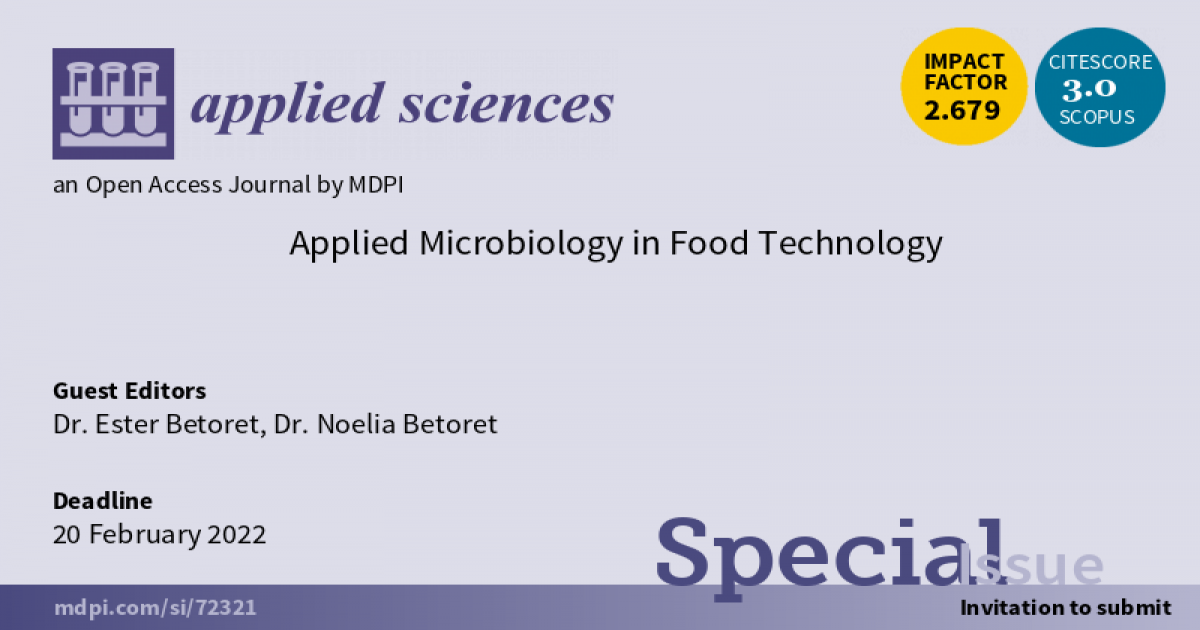Applied Microbiology in Food Technology
A special issue of Applied Sciences (ISSN 2076-3417). This special issue belongs to the section "Food Science and Technology".
Deadline for manuscript submissions: closed (20 February 2022) | Viewed by 23167

Special Issue Editors
Interests: food science and technology; food processing and engineering; functional food
Interests: food engineering; food processing; food science and technology; food waste valorization; functional foods development
Special Issues, Collections and Topics in MDPI journals
Special Issue Information
Dear Colleagues,
The importance of probiotic functional foods is already clear for science, governments, industries, and universities. A huge scientific knowledge on the effect of probiotic microorganisms, microbiota, and host health is being developed. An increased knowledge of the metabolic routes in the human organism, the development of innovative techniques to enhance probiotic properties, and the identification of bacterial consortia through bioinformatics are some of the most significant advances.
Probiotic foods can help to prevent or improve the treatment of physiological disorders (digestive, immune, metabolic, etc.), and they also represent a potential alternative strategy to fight excessive use of antibiotics which can produce antibiotic resistances and result in a high cost for European health systems, waste generation, and effluent contamination. However, the effectiveness of probiotic microorganisms is conditioned by several factors.
Foods are mostly complex mixtures of macro- and microcomponents organized in a structure that can trap active compounds, modulating their release or inhibiting their activity. There is currently little information regarding the extent to which the benefits of probiotics depend on the food matrix in which they are delivered.
This Special Issue focuses on research studies devoted to studying the effect of food technologies on probiotic microorganisms incorporated into a food matrix (liquid, solid or foam). Scientific or review papers addressed at determining the bioaccessibility of probiotic microorganisms after food processing or storage are welcome. Studies to elucidate, via in depth analysis, the interactions among ingredients during fermentation and processing, the determination of the functional properties of the probiotic microorganisms, and their interplay through gastrointestinal passage are topics of special interest.
Dr. Ester Betoret
Dr. Noelia Betoret
Guest Editors
Manuscript Submission Information
Manuscripts should be submitted online at www.mdpi.com by registering and logging in to this website. Once you are registered, click here to go to the submission form. Manuscripts can be submitted until the deadline. All submissions that pass pre-check are peer-reviewed. Accepted papers will be published continuously in the journal (as soon as accepted) and will be listed together on the special issue website. Research articles, review articles as well as short communications are invited. For planned papers, a title and short abstract (about 100 words) can be sent to the Editorial Office for announcement on this website.
Submitted manuscripts should not have been published previously, nor be under consideration for publication elsewhere (except conference proceedings papers). All manuscripts are thoroughly refereed through a single-blind peer-review process. A guide for authors and other relevant information for submission of manuscripts is available on the Instructions for Authors page. Applied Sciences is an international peer-reviewed open access semimonthly journal published by MDPI.
Please visit the Instructions for Authors page before submitting a manuscript. The Article Processing Charge (APC) for publication in this open access journal is 2400 CHF (Swiss Francs). Submitted papers should be well formatted and use good English. Authors may use MDPI's English editing service prior to publication or during author revisions.
Keywords
- probiotic
- functional foods
- technology
- processing
- bioaccessibility






